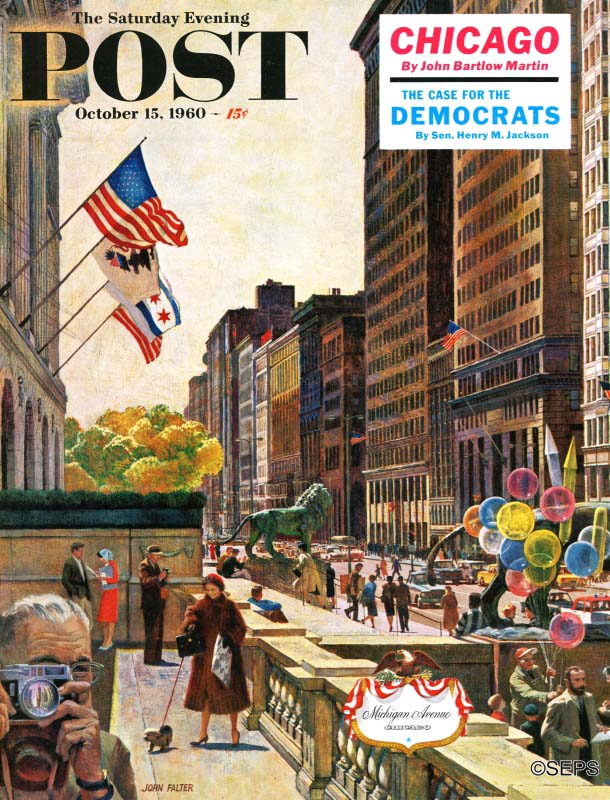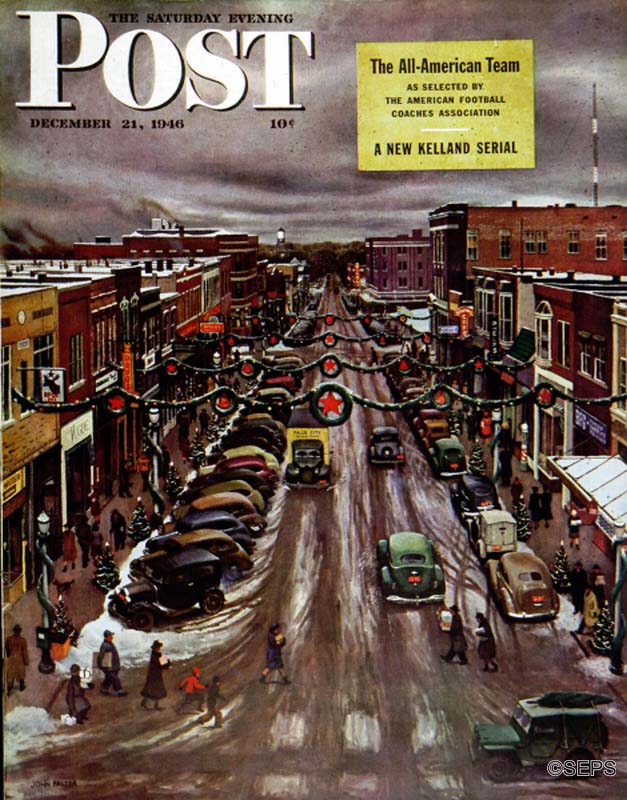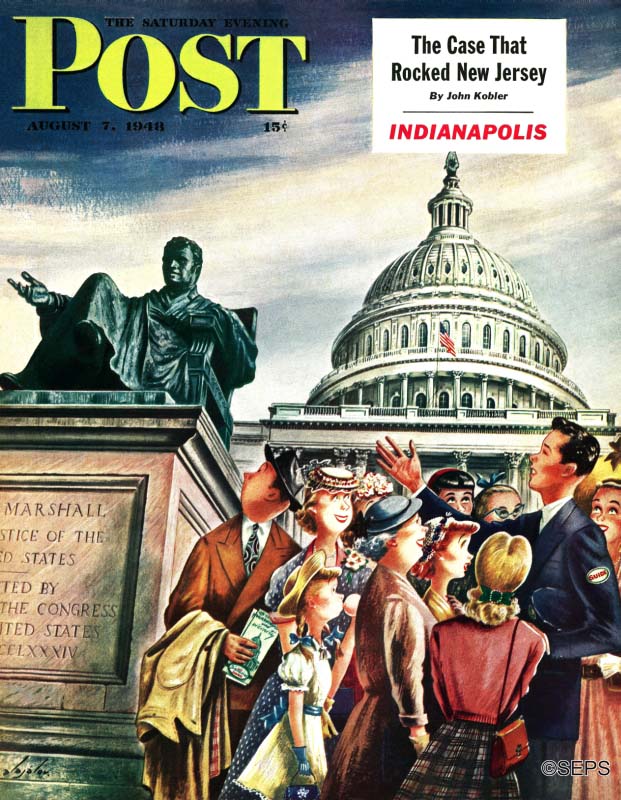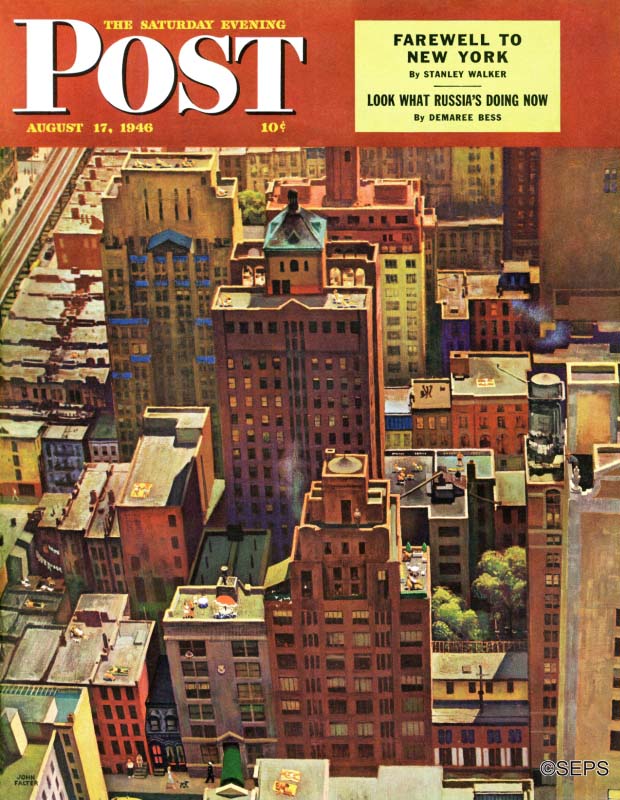Throughout the decades, Post artists have used their paintbrushes to recreate America’s vibrant cityscapes. Here are a some of our most memorable city covers.

Peachtree Street
John Falter
June 25, 1960
Georgia
John Falter depicted Peachtree Street at the Harris Street intersection, looking south toward Five Points. The gentleman on crutches at lower left is Ernest Rogers, who was an Atlanta Journal columnist and the popular “Mayor of Peachtree Street.”

Michigan Avenue, Chicago
John Falter
October 15, 1960
Illlinois
The standard picture-post-card view of Chicago is of Michigan Avenue, looking north toward the Tribune Tower and Wrigley Building. Artist John Falter gives us instead a southern exposure of this elegant avenue—with the Wrigley Building and environs reflected in the camera lens at left. Behind the lofty buildings on the right is the Loop; facing them are the Art Institute, set in Grant Park, and Lake Michigan. The whiskered gent with sketch pad is the late Louis Sullivan, Frank Lloyd Wright’s mentor and an architect who helped reshape the face of this frisky city. (Sullivan had an office in Orchestra Hall, the second building from right.) We thought we had spotted another eminent Chicagoan, Al Capone, in the foreground. But Falter assures us we’re imagining things.

Monument Circle, Indianapolis
John Falter
October 28, 1961
Indiana
Monument Circle takes its name from the limestone memorial to soldiers and sailors at its center. And the circle is at the very center of Indianapolis, which is right in the middle of the Hoosier state. Artist John Falter discerned a faintly French flavor in this scene — perhaps because Indianapolis was planned on the pattern of Washington, D.C., which was laid out by a Frenchman. But consider the English Gothic architecture of Christ Church Cathedral at the left, the vaguely Tudor air of the neighboring Columbia Club, and the bluntly modern design of the Fidelity Building. French, English, or just plain American, the circle suits a city with a half-Greek name.

Park Street, Boston
John Falter
January 7, 1961
Massachusetts
Welcome to historic Park Street circa 1961, looking north toward the gold-domed State House. To the left, Boston Common; to the right, the Old Granary Burial Ground, where lie Paul Revere, John Hancock and Samuel Adams. That’s Park Street Church in the foreground; its site is known as “Brimstone Corner.” The yule tree being carted off at lower left indicates that Christmas no longer is banned in Boston, as it was when the Puritans held sway. As for the 1913 Pierce Arrow approaching from the right, artist John Falter tells us it originally belonged to Boston astronomer Percival Lowell, brother of poet Amy Lowell.

Kansas City
John Falter
September 23, 1961
Missouri
Spanish architecture in Missouri? If such a state of affairs seems peculiar, consider that the unpredictable Show Me state even has a town named Peculiar (pop. 458), some twenty miles south of here, on U.S. 71. Our cover scene is in Kansas City, “the gateway to the Southwest,” and you are looking at the intersection where U.S. 50, gateway to the Country Club Plaza shopping center, crosses J. C. Nichols Parkway. This elegant community of shops was conceived and built by Jesse Clyde Nichols (1880-1950), to whom the fountain in the foreground is a memorial. The scene appealed to artist John Falter because the Old World architecture seemed to symbolize our nation’s roots — which is not to deny the notion expressed by lyricist Oscar Hammerstein in Oklahoma! that “everything’s up-to-date in Kansas City.”

Falls City, Nebraska at Christmas
John Falter
December 21, 1946
Nebraska
As a setting for his picture of the last-minute Christmas rush, John Falter chose the town where he spent his boyhood: Falls City, Nebraska. The finished job is a mixture of paint and recollection. That water tower in the distance, for example, was a favored roost for Falls City boys on hot summer nights. They liked to sleep there. City authorities met in some alarm — the surrounding platform is seventy-five feet above ground — and forbade it. Falter had no trouble recalling the Christmas rush. As a boy, he worked in his father’s clothing store on this street. A good many customers bought new outfits for the holidays, and young Falter was the pants runner — he ran trousers from the store to the tailor’s, to get them shortened. Only customers appear in this painting. But the artist’s sympathies doubtless are with those on the selling side of the counter.

Independence Hall, Philadelphia, Pa.
Allen Saalburg
June 2, 1945
Pennsylvania
In 1945, Independence Hall was just across the way from the Post. Allen Saalburg’s painting is a view of Independence Hall looking west. The building at the left was The American Philosophical Society. The Post’s offices were directly behind the trees in the left foreground.

Tourists in Washington D. C.
Constantin Alajalov
August 7, 1948

Bird’s-Eye View of New York City
John Falter
August 17, 1946

San Francisco Cable Car
Mead Schaeffer
September 29, 1945